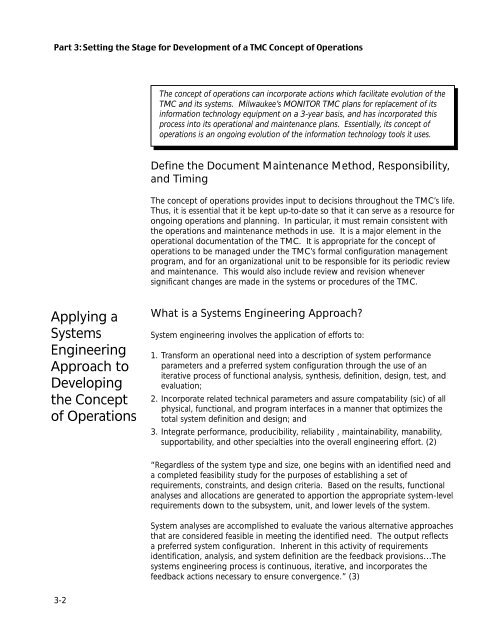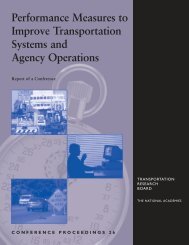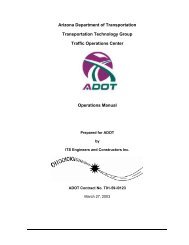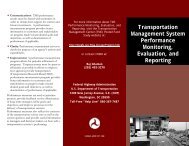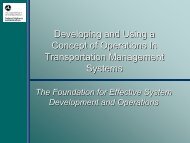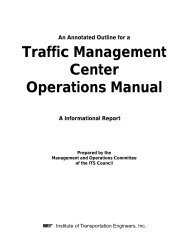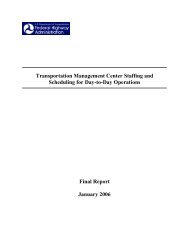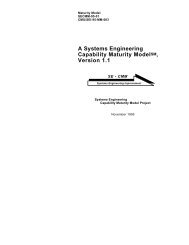Transportation Management Center Concepts of Operations
Transportation Management Center Concepts of Operations
Transportation Management Center Concepts of Operations
- No tags were found...
Create successful ePaper yourself
Turn your PDF publications into a flip-book with our unique Google optimized e-Paper software.
The concept <strong>of</strong> operations can incorporate actions which facilitate evolution <strong>of</strong> theTMC and its systems. Milwaukee’s MONITOR TMC plans for replacement <strong>of</strong> itsinformation technology equipment on a 3-year basis, and has incorporated thisprocess into its operational and maintenance plans. Essentially, its concept <strong>of</strong>operations is an ongoing evolution <strong>of</strong> the information technology tools it uses.Define the Document Maintenance Method, Responsibility,and TimingThe concept <strong>of</strong> operations provides input to decisions throughout the TMC’s life.Thus, it is essential that it be kept up-to-date so that it can serve as a resource forongoing operations and planning. In particular, it must remain consistent withthe operations and maintenance methods in use. It is a major element in theoperational documentation <strong>of</strong> the TMC. It is appropriate for the concept <strong>of</strong>operations to be managed under the TMC’s formal configuration managementprogram, and for an organizational unit to be responsible for its periodic reviewand maintenance. This would also include review and revision wheneversignificant changes are made in the systems or procedures <strong>of</strong> the TMC.Applying aSystemsEngineeringApproach toDevelopingthe Concept<strong>of</strong> <strong>Operations</strong>What is a Systems Engineering Approach?System engineering involves the application <strong>of</strong> efforts to:1. Transform an operational need into a description <strong>of</strong> system performanceparameters and a preferred system configuration through the use <strong>of</strong> aniterative process <strong>of</strong> functional analysis, synthesis, definition, design, test, andevaluation;2. Incorporate related technical parameters and assure compatability (sic) <strong>of</strong> allphysical, functional, and program interfaces in a manner that optimizes thetotal system definition and design; and3. Integrate performance, producibility, reliability , maintainability, manability,supportability, and other specialties into the overall engineering effort. (2)“Regardless <strong>of</strong> the system type and size, one begins with an identified need anda completed feasibility study for the purposes <strong>of</strong> establishing a set <strong>of</strong>requirements, constraints, and design criteria. Based on the results, functionalanalyses and allocations are generated to apportion the appropriate system-levelrequirements down to the subsystem, unit, and lower levels <strong>of</strong> the system.System analyses are accomplished to evaluate the various alternative approachesthat are considered feasible in meeting the identified need. The output reflectsa preferred system configuration. Inherent in this activity <strong>of</strong> requirementsidentification, analysis, and system definition are the feedback provisions…Thesystems engineering process is continuous, iterative, and incorporates thefeedback actions necessary to ensure convergence.” (3)3-2


